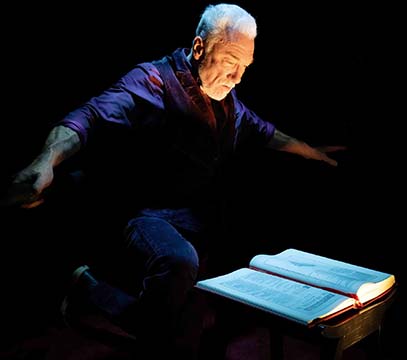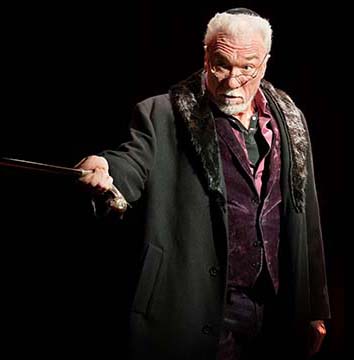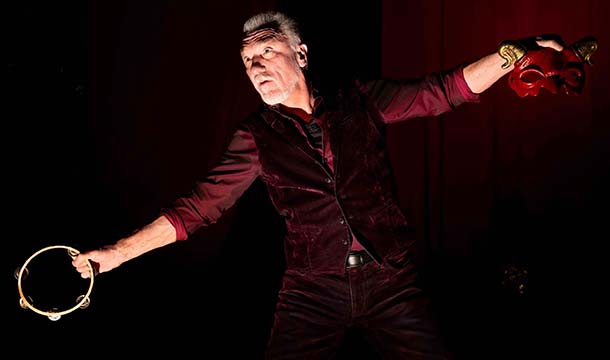By Lucy Komisar
Patrick Page’s brilliant one-man show on how Shakespeare invented the villain is a combination of theater piece, master class and college literature lecture. In a purple pullover and vest, before a red curtain, through his acting and explanations, he shows how William Shakespeare developed his villainous characters from crudely evil to confounded with moral dilemmas, even if they defeated conscience and killed at the end. And how he dealt with the mythology of evil in popular culture, such as the Jew as rapacious money-lender and Lady Macbeth conjuring evil spirits.
He deals with a selected handful of characters from the 37 plays. Hardly necessary to say that his actor’s voice creates the characters, from harsh and threatening to soft and desperate. With excellent direction by Simon Godwin. But more important, he introduces them with explanations of how they fit in Shakespeare’s development of evil. Taking the characters in chronological order, he shows how evil and its partners, jealousy, ambition and revenge, as time goes on become more complex and reveal the human spirit.
In 1572, Shakespeare was 8 when players came to Stratford doing Morality plays. The Vice character represented greed and jealousy. Page notes that Shakespeare’s father was the mayor, and he would have gotten a front row seat.
Years later, Aaron the moor in Shakespeare’s military play “Titus Andronicus” was fulsome evil.
But from a youthful idea of evil, he would make its cruelty more real, seeking to show how the villain got to that behavior.
Plague closed the theater for a few years. Shakespeare wrote sonnets.
Page sets the stage for the 1597 “Merchant of Venice,” which he points out was about Antonio the merchant, not Shylock. But Shakespeare needed a Jewish villain for his anti-Semitic audience. Fascinating then how they would have reacted to his challenging language: “If they prick us, do we not bleed.” Is Shylock’s demand for a pound of flesh revenge or evil? (Imagine “If they prick us, do we not bleed?” done in Israel with Shylock as a Palestinian.)
Shakespeare would become, as they say, “rich and famous.” Buy a big house in Stratford. Become a shareholder in the Globe Theater in London.
But in his plays, he mocked social climbers such as the “Twelfth Night” comic villain Malvolio who dreams of becoming a count. It’s the others who take revenge by humiliating him.
Shakespeare’s revenge stories are the thrillers of his day.
On the far side of evil is the hunchbacked Richard III, whose deformity in the view of audiences made him born to be bad. In Page’s voice, he snarls.
But more interesting, because more complex, is Claudius. Hamlet’s uncle Claudius is a murderer, but Shakespeare has him go into the chapel stricken with guilt and remorse at having killed his brother.
Worse, Page paints Iago in “Othello “as a psychopath, even citing a medical textbook on the qualities he displays.
The darkest play, whose name actors believe brings bad luck to say (they just call it “the Scottish play”) is steeped in evil. Page changes to all black garb. But even Macbeth, full of vanity and ambition, appears enticed to plot murder of the king only when the three sisters predict he will rule.
At the end of the villain plays, “The Tempest” depicts Prospero, who had been overthrown, forced out of his rightful position and exiled with his daughter. But here, Page shows how in the end, virtue can overcome vengeance.
Later, in a talk-back, he said his favorite role was King Lear. There was “a lot of darkness!” But brilliant light for the rest of us. A memorable event!
“All the Devils are Here: How Shakespeare Invented the villain.” Created and performed by Patrick Page. Directed by Simon Godwin. Daryl Roth Theatre, 103 East 15th Street (east of Union Square), NYC. Runtime 1:30. Tkts. Opened Oct 16, 2023, closes March 31, 2024. Review on NY Theatre Wire.





